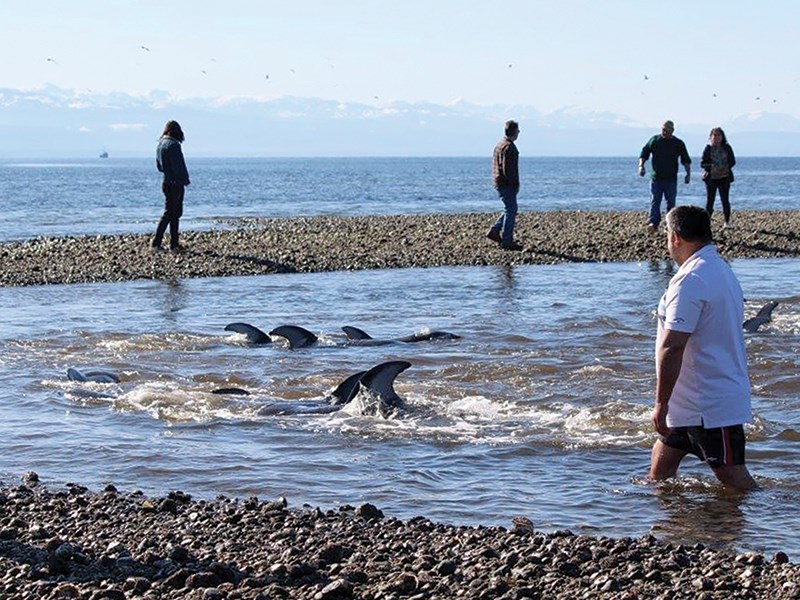A group of concerned citizens rescued a pod of Pacific white-sided dolphins which had been chased inshore at Tla’amin Nation by a pod of orcas and then trapped by the falling tide on the afternoon of Monday, March 16.
“I was driving by around 1:30 pm when I saw the pod near shore, in very tight proximity and going around in circles,” said Derek Poole. “I spend a lot of time on the beach and you don’t see that very often.”
Poole discovered the orcas when he launched his drone for photos and videos. “That was likely why the dolphins had come so close to shore,” he said.
The dolphins had taken refuge in an old fish trap at Tla’amin. “When we were kids, we used to go down there when the tide went out to catch herring that had gotten caught in the pool,” said Lee George, a Tla’amin community member. “It was really the only place on this part of the coast for the dolphins to hide, but they got stuck when the tide started falling.”
George and Phil Russell were among the members of the community who were observing the dolphins. “Lee realized that this was turning into a rescue,” said Russell. “We made phone calls to the Department of Fisheries and Oceans and to a few more people who know about rescuing whales. Lee went home to get tarps and his waders, but the water was going down really quick and the dolphins were starting to go belly-up in the shallow water. So myself, Russell Francis, and another fellow named Barry got in there and started pulling the dolphins out to the channel.”
Barry Rice, one of the first people in the pool with Russell, acknowledged that the first rescues were not the right way to go about it (see sidebar). “We knew that they needed to be carried with a tarp or blanket, but you can’t just stand there and watch someone in a burning building without helping,” he said. “We did the best we could with what we had, and when others arrived with tarps, everything went a lot smoother.”
The 16 dolphins, each weighing between 330 and 440 pounds, were carried out through the shallow channel to deeper water. It took about an hour to release the pod. “I realized after I got one of the dolphins out that I am not in as good a shape as I thought,” said Russell.
Michele Moir, another rescuer at the pool, agreed. “They were very heavy, but you kind of go into rescue mode and just lift,” she said. “I’m just glad we were there to help, and I hope they’ll be okay.”
Many people helped rescue the dolphins from the pool. “There were people of all ages helping, even my granddaughter,” said George. “I told her about the [dolphins] when I was getting the tarps together, and when I came out of the house, she had already pedalled her bike across to the pool. By the time I got there, she was in water up to her ankles.”
George commended everyone who did what they could for the dolphins. “This event really showed that people and communities can come together to do something good for Mother Nature,” he said.
The Peak received the following information from Peter Hamilton, LifeForce Ocean Friends, about the way to rescue cetaceans if provided with an ideal situation:
1. Do not attempt to move the whale or dolphin without the proper equipment and expertise, since the weight of the animal will cause severe scrapping of the skin, damage to internal organs, damage to the flippers and tail, and will normally be unsuccessful in the end. In no instance attempt to move it by its flippers or by pulling it by the tail or tail stock by human power, machine or boat. This can cause spinal cord injuries, et cetera. If an animal is rolled onto its flippers, irreparable damage can be caused. Do not allow an animal to roll onto its back so that the blowhole is covered.
2. Animals must not be dragged. They must be picked up and transported. For large animals, heavy equipment is necessary in some cases. For small mammals, this can be done with a number of individuals using a tarpaulin.



